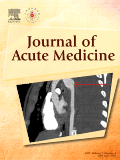
Journal of Acute Medicine
Scope & Guideline
Shaping the future of critical and emergency medicine.
Introduction
Aims and Scopes
- Acute Care and Emergency Medicine Research:
The journal publishes studies that explore various aspects of acute care, including assessment, diagnosis, and treatment of emergency conditions across diverse patient populations. - Clinical Case Reports and Observational Studies:
It includes unique case reports and observational studies that highlight rare conditions, complications, and innovative treatment approaches in emergency medicine. - Infectious Disease and Public Health:
Research on infectious diseases, particularly in the context of public health challenges like COVID-19, is a significant focus, exploring epidemiology, treatment outcomes, and preventive measures. - Emergency Medical Services and Systems:
The journal examines the organization and effectiveness of emergency medical services, including protocols, training, and community health strategies. - Innovative Technologies and Methodologies:
There is a consistent emphasis on the integration of new technologies and methodologies, including molecular diagnostics and simulation training, to improve emergency care delivery.
Trending and Emerging
- COVID-19 Related Research:
A significant increase in studies addressing the clinical management, outcomes, and implications of COVID-19 within emergency care settings demonstrates the pandemic's profound impact on acute medicine. - Use of Biomarkers for Prognosis:
Research on the use of biomarkers, such as procalcitonin and CRP, in predicting patient outcomes is trending, highlighting the need for rapid assessment tools in acute settings. - Telemedicine and Remote Care:
There is a growing interest in telemedicine applications within emergency care, especially for triaging and managing patients remotely, which has become critical during the COVID-19 pandemic. - Disaster Preparedness and Response:
Emerging themes focus on disaster preparedness strategies and the integration of crowd analysis in emergency medical responses, reflecting a proactive approach to managing large-scale crises. - Technological Innovations in Diagnostics:
The use of advanced diagnostic technologies, such as rapid PCR testing and 3D printing for medical applications, is gaining traction, emphasizing the role of innovation in improving emergency care.
Declining or Waning
- Chronic Disease Management:
Research related to chronic disease management in emergency settings has decreased, as the journal has shifted its focus to acute conditions and immediate interventions. - Traditional Surgical Techniques:
There is less emphasis on traditional surgical techniques in emergency medicine, as innovative minimally invasive procedures and interventional radiology gain prominence. - Psychiatric Emergencies:
The exploration of psychiatric emergencies appears to be declining, possibly due to a shift towards integrated care models and the increasing focus on physical health emergencies. - Basic Life Support Protocols:
Studies on basic life support protocols have become less frequent, with more attention being directed toward advanced life support and critical care techniques.
Similar Journals

African Journal of Emergency Medicine
Connecting Researchers and Practitioners for Impactful CareAfrican Journal of Emergency Medicine, published by ELSEVIER, serves as a pivotal platform for disseminating innovative research and advancements in emergency medicine and critical care nursing. Launched in 2011, this Open Access journal has quickly garnered attention for its commitment to enhancing healthcare delivery across Africa, catering to a diverse audience of researchers, practitioners, and students. With an impressive rank of #44/109 in Emergency Medicine and positioning itself in the Q2 category for Critical Care Nursing and Emergency Nursing in 2023, the journal has established itself as a significant contributor to the medical community. The journal encourages the submission of high-quality research, reviews, and case reports that can inform clinical practices and emergency protocols across the continent. Its accessibility, reflected by its open access model, ensures that vital findings are available to those who need it most, thus fostering greater collaboration and innovation in emergency healthcare. With a focus on improving patient outcomes and advancing the field, the African Journal of Emergency Medicine is an essential resource for all who are committed to emergency care and related disciplines.
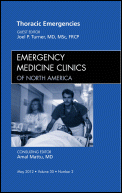
EMERGENCY MEDICINE CLINICS OF NORTH AMERICA
Empowering Practitioners with Cutting-Edge KnowledgeEMERGENCY MEDICINE CLINICS OF NORTH AMERICA, published by W B SAUNDERS CO-ELSEVIER INC, stands at the forefront of the field of emergency medicine, providing a vital platform for interdisciplinary research and clinical insights. With an ISSN of 0733-8627 and E-ISSN 1558-0539, this journal has been a cornerstone for emergency medicine professionals since its inception in 1983 and continues to publish annually through 2024. The journal's impact is reflected in its 2023 Scopus ranking, where it is positioned #42 out of 109 in the emergency medicine category, securing a respectable Q2 quartile status. Although it does not offer open access at this time, its commitment to advancing emergency medicine knowledge is evident through its rigorously peer-reviewed articles that address critical clinical practices, evolving technologies, and important case studies. As a resource for researchers, practitioners, and students alike, EMERGENCY MEDICINE CLINICS OF NORTH AMERICA invites you to explore the latest trends and developments in this essential field of healthcare.

Emergency Radiology
Transforming Emergency Medicine Through Radiology InsightsEmergency Radiology, published by SPRINGER HEIDELBERG, is a leading journal in the fields of emergency medicine and radiology, dedicated to advancing the understanding and application of diagnostic imaging in urgent medical conditions. Established in 1994, this journal has consistently contributed to the discourse around emergency diagnostics, maintaining a strong position within the academic community, as evidenced by its Q2 rankings in both Emergency Medicine and Radiology, Nuclear Medicine and Imaging categories as of 2023. With a distinguished focus on innovative research and case studies, it serves a diverse audience of researchers, clinicians, and healthcare professionals who seek to enhance their knowledge and improve patient outcomes in emergency settings. While the journal is not currently open access, it offers robust subscription options and continues to be an integral resource for those at the forefront of emergency care. With an ISSN of 1070-3004 and an E-ISSN of 1438-1435, Emergency Radiology is positioned to remain a key player in shaping the future of medical imaging through its commitment to high-quality research and evidence-based practices.

Journal of the American College of Emergency Physicians Open
Leading the Charge in Emergency Medicine AdvancementsJournal of the American College of Emergency Physicians Open is a prominent Open Access journal published by WILEY that has been committed to advancing the field of emergency medicine since its inception in 2020. As a vital resource for researchers, clinicians, and students, this journal aims to disseminate innovative research findings, clinical guidelines, and educational resources that support the rapidly evolving landscape of emergency care. With a solid Q1 ranking in the emergency medicine category and positioned within the top 25 ranks of Scopus’ emergency medicine listings, the journal ensures high visibility and accessibility for critical research. As an open-access publication, it provides unrestricted access to its content, facilitating knowledge sharing and collaboration among professionals globally. The journal's significant impact on the field is reflected in its growing influence, underlining its relevance as an essential platform for advancing emergency medicine practice and research.

Current Emergency and Hospital Medicine Reports
Advancing Emergency Care Through Rigorous ResearchCurrent Emergency and Hospital Medicine Reports, published by Springer, is a pivotal journal in the field of emergency and hospital medicine. With a commitment to disseminating crucial research and advancements, this journal serves as a platform for sharing high-quality studies that enhance clinical practices and improve patient outcomes. As an important resource for researchers, healthcare professionals, and students, it caters to the growing need for evidence-based knowledge in emergency medicine. Although currently not classified as open access, the journal offers a wealth of information that aligns with the latest innovations and practices in the discipline. By engaging with diverse topics, from clinical interventions to hospital management strategies, it aims to inform and inspire the next generation of practitioners and scholars in this vital field of medicine. With its ISSN of 2167-4884, Current Emergency and Hospital Medicine Reports is dedicated to advancing the frontiers of emergency healthcare through rigorous research and illuminating insights.

Internal and Emergency Medicine
Exploring the Nexus of Emergency and Internal MedicineInternal and Emergency Medicine is a highly regarded academic journal published by Springer-Verlag Italia SRL, dedicated to advancing the fields of emergency medicine and internal medicine. With an impressive Q1 ranking in Emergency Medicine and a Q2 ranking in Internal Medicine as of 2023, the journal serves as a vital platform for researchers and professionals alike seeking to disseminate pioneering findings and innovative practices. Established in 2006 and operational until 2024, the journal focuses on the intersection of these critical medical domains, providing insight into urgent clinical challenges and everyday internal medicine cases. Although currently not open access, it offers subscription options for readers aiming to deepen their knowledge in these essential areas of healthcare. The journal’s contributions are instrumental in shaping medical protocols and enriching the education of students and practitioners globally, all while based in the heart of Italy, specifically Milan.

BMC EMERGENCY MEDICINE
Leading the way in emergency medicine scholarship.BMC Emergency Medicine is a premier, open-access journal that has been at the forefront of the field of emergency medicine since its inception in 2001. Published by BMC in the United Kingdom, this journal is distinguished by its impact factor and remarkable Q1 ranking in emergency medicine, placing it among the top-tier publications in this vital area of healthcare. With a current Scopus rank of #30 out of 109 in the category of Emergency Medicine, and occupying the 72nd percentile, BMC Emergency Medicine is a leading platform for researchers and practitioners alike to disseminate their findings related to urgent and critical care. The journal embraces a broad scope within emergency medicine, encouraging submissions on a wide range of topics including clinical practice, innovative techniques, public health, and policy issues that critically affect emergency care. The open-access model ensures that high-quality research is readily available to the global community, fostering collaboration and advancing knowledge in the field. For those dedicated to improving patient outcomes in emergency settings, BMC Emergency Medicine represents an invaluable resource and community.
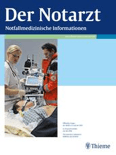
Notarzt
Advancing critical care knowledge for a healthier tomorrow.Notarzt is a well-regarded academic journal published by GEORG THIEME VERLAG KG, focusing on critical care, intensive care medicine, and emergency medicine. With an ISSN of 0177-2309 and an E-ISSN of 1438-8693, this German-based journal has been contributing to the medical field since its inception in 1985. Despite being categorized in the Q4 quartile for both Critical Care and Intensive Care Medicine and Emergency Medicine, Notarzt continues to provide a platform for innovative research, case studies, and developments that inform practitioners and researchers alike. With a publication history spanning significant years such as 1993 and 1999 to 2024, Notarzt is dedicated to improving outcomes in emergency and critical care settings through the dissemination of pivotal findings and comprehensive reviews. Although currently not an Open Access journal, it remains an essential resource for professionals striving to stay abreast of developments in their field.
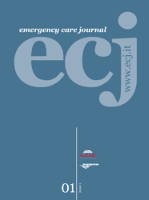
Emergency Care Journal
Fostering Global Collaboration in Emergency Care ResearchThe Emergency Care Journal is a vital open-access publication dedicated to the field of emergency medical services and nursing, published by PAGEPRESS PUBL. Since its inception in 2005, the journal has aimed to provide a platform for researchers, clinicians, and scholars to share knowledge and advance practices in the critical domain of emergency care. With an ISSN of 1826-9826 and an E-ISSN of 2282-2054, the journal is committed to enhancing accessibility and reaching a global audience. Although its Scopus rankings reflect a competitive landscape, particularly in the ranks of Health Professions and Emergency Medicine, the journal continues to serve as an essential resource for emerging studies and professional insights. Nestled in Italy, the journal seeks to bridge the gap between academic research and real-world application, ultimately improving patient care and outcomes in emergency settings. As it converges into the years 2023 and 2024, Emergency Care Journal stands poised to foster scholarly discussions and innovative research that are crucial to the evolving landscape of emergency medicine.
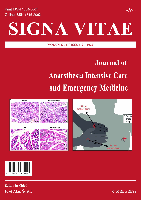
Signa Vitae
Innovating patient care through groundbreaking research.Signa Vitae is a distinguished academic journal published by MRE PRESS, focusing on critical care, intensive care medicine, and emergency medicine. Established in 2008 and running through 2024, this journal serves as an essential conduit for the dissemination of innovative research and clinical practices in these dynamic fields. Based in Croatia, Signa Vitae is indexed in Scopus, highlighting its importance within the scholarly community, boasting respectable quartiles with a Q3 ranking in both Critical Care and Intensive Care Medicine and Emergency Medicine as of 2023. Although it operates under a traditional access model, the journal aims to enhance knowledge sharing and interdisciplinary dialogue among researchers, healthcare professionals, and students globally, addressing the urgent challenges and advancements in patient care. By providing a platform for high-quality studies and reviews, Signa Vitae continues to advance the conversation and practice within critical and emergency medicine.